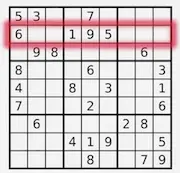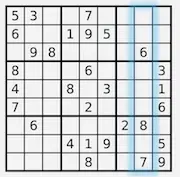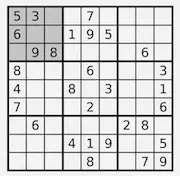How to play Sudoku
Sudoku consists of a 9x9 grid, which is divided into nine 3x3 boxes.
The goal is to fill in the empty cells with numbers from 1 to 9, without repeating any number in the same row, column, or box.



You don't have to guess to fill in the numbers, each Sudoku has only one unique solution that can be reached through logic and solving techniques that we teach here.
How to play Sudoku for beginners
Our beginner's guide is designed to introduce you to the world of Sudoku gently.
There are some straightforward techniques you can easily spot on a Sudoku grid.
Full House / Last Digit
When only one cell is left empty in a house (row, column or a box), the missing number is the one that hasn't been used yet in that row, column, or box.
In this example the box is all filled except one number, so 7 is the missing one:


The following row has only 1 empty cell, you can easily tell which number is missing:


Hidden Singles
A Hidden Single occurs when a particular digit can only fit in one specific cell within a given house (row, column, or box).
Let's examine the following box and determine the potential cells where the digit '1' could be placed in that house.


Looking at related rows and columns, we can see in which cells in the box the number 1 cannot appear, they are marked in grey:


This leaves only one possible cell where 1 can exist, we solved this cell:


Naked Singles
Buddy cells are cells that are in the same house (same row, same column or same box).
Take a look at this Sudoku and the highlighted cell, all it's buddy cells are marked:


Naked singles technique is eliminating all possible candidates of a cell until we are left with only one. Let's do that:


We are left with only one possible candidate for this cell - so it must be the solution.


With practice, you'll quickly learn to recognize these techniques and to solve easy sudoku for beginners.
Let's start with an easy sudoku right now, have fun!
Advanced Sudoku techniques
Take your Sudoku skills to the next level with advanced techniques that challenge even the most experienced solvers.
Learn the art of pattern recognition with strategies using our step by step guides:
These methods are invaluable for tackling the toughest grids and require a deep understanding of Sudoku logic to apply effectively.
Learn how to solve sudoku step by step:














>> use checkboxes to track your progress.
Sudoku Tips and Tricks
While it relies heavily on logic and reasoning, there are certain tips and tricks that can make solving these puzzles more manageable and enjoyable.
Start Simple
If you're new to Sudoku, begin with easier puzzles. These usually have more numbers filled in and require straightforward logic to solve. As you gain confidence, gradually move to more challenging puzzles.
The Importance of Scanning
Regularly scan the rows, columns, and boxes. This helps in quickly identifying which numbers are missing and where they might fit. A systematic approach, like going number by number or box by box, can be very effective.
Key Strategies for Game Improvement
Use Pencil Marks
In trickier puzzles, it's beneficial to write down potential numbers (candidates) in each cell. This visual aid is invaluable for applying more advanced techniques.
Check out how to use pencil marks video.
Focus on One Number at a Time
Concentrate on placing one number throughout the grid before moving on to the next. This methodical approach often reveals new opportunities that weren't apparent initially. Use our highlight feature to focus on one number easily.
Look for the Definites
Start with the most obvious placements. If a number can only fit in one spot in a row, column, or box, place it there. This may seem basic, but it sets a strong foundation for the rest of the puzzle.
Tips for Avoiding Common Pitfalls
Avoid Guessing
Sudoku is a game of logic, not chance. Guessing can lead to errors and frustration. If you're stuck, step back and reassess rather than making a random choice.
Take Breaks
Sometimes, taking a short break can provide a fresh perspective, helping you spot solutions you might have missed earlier.
Use Process of Elimination
If you're struggling to place a number, try eliminating where it cannot go. This process of elimination often reveals the correct placement.
Enhancing Your Experience
Join a Sudoku Community
Engage with other Sudoku enthusiasts. Join our Sudoku Facebook group with over 7000 members to discuss and solve the daily Sudoku. We also have a Whatsapp and Telegram communities.
Challenge Yourself
Once comfortable with basic puzzles, don’t shy away from more complex ones. Each puzzle is a new adventure and an opportunity to improve.
Practice Regularly
Like any skill, proficiency in Sudoku comes with practice. Regularly engaging with puzzles enhances your problem-solving skills and speeds up your ability to recognize patterns.
Conclusion
Sudoku is more than just a number game; it's a mental workout that improves logic and concentration. By incorporating these tips and tricks into your Sudoku routine, you can enhance your enjoyment of the game and develop your problem-solving abilities. Remember, every puzzle solved is a step forward in your Sudoku journey!

